In the 1996 movie Phenomenon, John Travolta plays a small-town mechanic whose brain tumor stimulates an area of gray matter he didn’t know he had. Suddenly, he sees everything around him with greater acuity and understanding, and he feels connected to all living things.
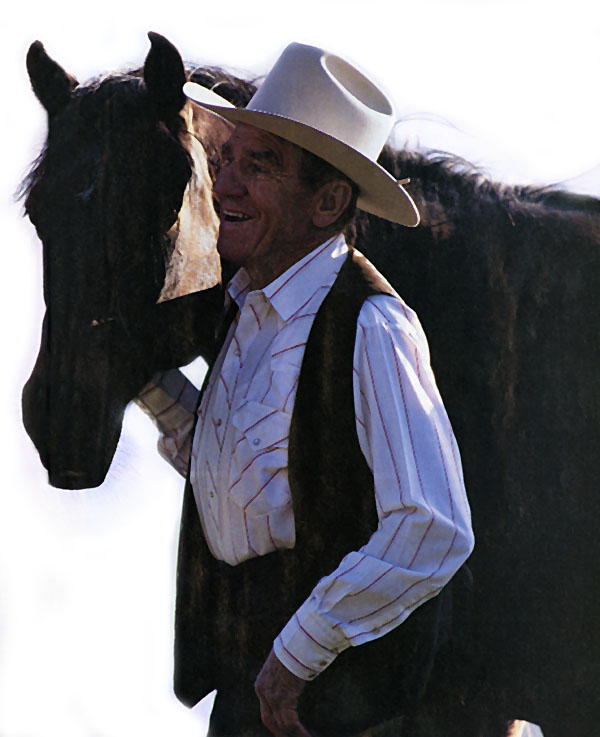
An encounter with Tom Dorrance, the 87-year-old revered as the horseman’s horseman, is a lot like that. I discovered this while researching the relative merits of feeding treats to horses by hand, a practice endorsed by some but shunned by others as a cause of nipping. Hand-feeding is generally a no-no in my book, so when I called Tom Dorrance for his view, I was expecting a thumbs-down on the practice. Fifteen minutes later, I felt like the guy in Phenomenon—a whole new area of my brain had been opened.
Tom’s answer, in essence, was, “It all depends.” If you hand-feed judiciously, watching closely and withholding the treat at the first sign of naughtiness, your horse will associate getting a goodie with good behavior, and never learn to nip. Be careless, however, and you’ll quickly create a rogue.
Well, Duh!
It was a slap-on-the-forehead moment. Why hadn’t I thought of that?
Why? Because I’m accustomed to right-or-wrong, yes-or-no, tab-A-into-slot-B thinking. The writing I do requires a “how-to” mentality: how to get your horse to do this, how to get him to do that. Tom’s thinking is infinitely more subtle and varied, a mirror of the horse’s mind itself, the source of most of Tom’s wisdom.
“That’s not how a horse thinks,” he’ll say, offering instead a savvier insight.
Without knowing Tom, you might assume he’s another one of “those” guys: talented trainers who have a way with horses and have learned to capitalize on it. He’s not. He’s never capitalized on anything in the half-century or more he’s been sharing what he knows. He cares only about helping horses by helping their riders understand them.
“I liked it better when no one knew anything about me,” he says wistfully. But it’s too late for that.
Today he’s recognized as the grandfather of the movement away from brute force in horse training in favor of patience and communication. This kinder, gentler cowboy has been inducted into the National Cowboy Hall of Fame (see “Dossier,” below), and is acknowledged by name in the best-selling novel, The Horse Whisperer.
He inspires an almost transcendent admiration among those who know him, a fact that makes him acutely uncomfortable. In his mind, he’s definitely not a guru; he’s simply the horse’s friend.
Salt of the Earth
“He’s the best horseman that ever was,” says Bob Barrett, head of the horse-handling programs at California’s Merced College.
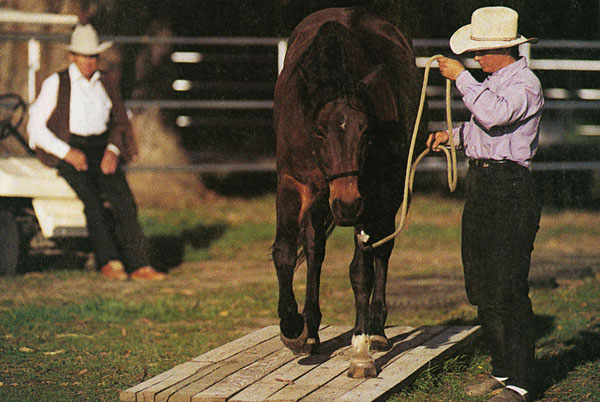
“He’s the greatest, and there’ll never be another like him,” agrees three-time National Reined Cow Horse Association Snaffle Bit Futurity champion Greg Ward, who for several years asked Tom to come to his ranch each January to help direct the colt-starting.
Tom’s influence has been felt in other competitive arenas as well; cutter Doug Jordan (winner of the National Cutting Horse Association Superstakes) and reiner Craig Johnson (winner of the National Reining Horse Association Futurity) are among scores of winning Dorrance devotees.
Tom is also a mentor to such well-known protégés as Ray Hunt and Buck Brannaman, proving that his approach can be learned and isn’t just the province of one gifted man.
His ways. Curious about the details of his technique? You won’t find them here. His methods defy encapsulation, and Tom has learned to discourage even the attempt. Without the deeper understanding to go with it, any effort to describe what he does risks triviality.
What you will find is insight into the man himself and, through that, a glimpse at the core of his approach, which as attitude. (And if you doubt your own attitude could use some adjusting, ask yourself if you’ve ever jerked on your horse’s mouth, or swatted him more than twice in a row, or used equipment that coerced his submission. If you have, you’re likely more intent on exacting obedience than on developing a willing partnership, and a touch of Tom’s wisdom may be exactly what you—and your horse—need.)
Our talk. Though publicity-shy, Tom agrees to let me interview him for an in-depth H&R profile. I arrive at his home in the oak-lovely hills of Salinas, California, loaded with questions, many of them outgrowths of interviews I’ve already conducted with his friends and acquaintances.
Tom comes to the door and welcomes me with a hug, putting me instantly at ease— mark of a true gentleman. He’s equally gracious with my husband and daughter, who are along for the ride.
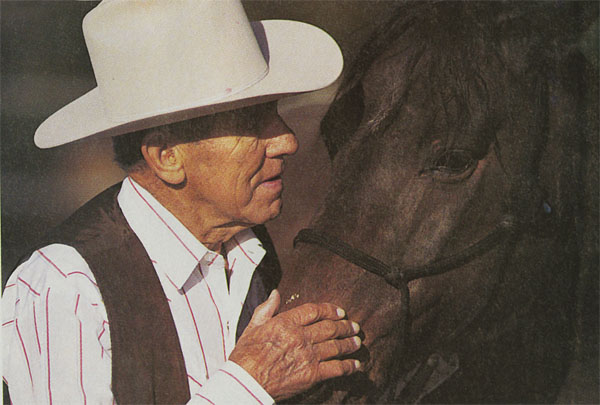
Now hobbled with arthritis, Tom keeps his walking sticks handy by anchoring them to his belt with cords.
“It worked with my mittens when I was a little guy, so I figured it’d work now,” he says with a chuckle, poking fun at himself in the way that’s endeared him to everyone he’s met.
For a man with no children of his own, he’s amazingly attuned to my 2 1/2-year-old, who wanders in and out of the house under her dad’s watchful eye.
“This is the first priority,” he says, patting her head. “What we’re doing comes second.” I’m beginning to see why everyone I’ve talked to refers to this man with reverence. As his story unfolds, I learn what may be the root of his iconic persona—good, old-fashioned family values.
His Roots
Born in 1910 outside Joseph, Oregon, Tom was the sixth of eight children, youngest of the four boys and, by his own description, the runt of the family. His parents were hard-working ranchers who raised their children with a mixture of loving discipline and benign neglect.
“I had the freedom to explore and experiment, so I could develop my own character,” says Tom. “That could have been the foundation for me to find, as I worked with animals, that this was as important to them as it had been to me.”
Tom remembers sprawling as a young child amidst the family dogs, rubbing the soft hair of their ears in a way that was satisfying to all concerned. When his mother found him so, she didn’t reprimand him, but merely suggested that such coziness might not be a good idea, given the hygiene of outdoor dogs.
Tom not only followed her guidance, he also filed away the details of her nonassertive approach for future use.
He had plenty of opportunity to mull things over.
Thoughtful youngster. “Tom was often alone as a child—he spent a lot of time with nature, becoming very connected to it as a result,” reveals Millie Hunt Porter, the author who helped him with his book, True Unity.
“Or it could be he just never lost the connectedness that perhaps all of us are born with,” she adds thoughtfully.
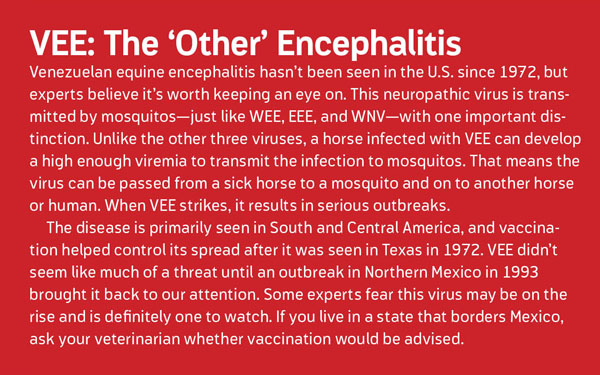
Attentive and watchful of everything surrounding him, young Tom learned as much from his family, animals, and neighbors as he did at school.
“I was aware at an early age that I could incorporate good ideas from others by being observant,” he says. “And if I messed up, there was often no one there to ‘clean up,’ so I had to think things through to try and get it right the first time.”
By watching horses interact at liberty, he learned the best way to pet a horse—not patting or stroking with the flat of the hand, as is common, but digging in firmly with bunched fingers, in a circular motion, to mimic the way one horse grooms another with its upper lip.
His mounted experience came as he traveled the 3 miles to and from school, or rode out to check on the cattle, or helped saddle-break the colts. Always, he tried to see things from the horse’s point of view.
“He never made the horses do something they didn’t understand,” recalls Tom’s brother Bill, on whose property in Salinas Tom and his wife, Margaret, now live. “Tom understood the feelings of a horse—why he does the things he does.”
Spreading the Word
As his older siblings grew up and left home, Tom remained on the ranch to help his aging parents. Thus it wasn’t until April of 1960, after both parents had died and the last of the property in Wallowa County had been sold, that Tom set out on his own as a 50-year-old bachelor.
By that time, he had a strong urge to share what he knew about training horses, so he bought a small house trailer and traveled about, dividing his time between California and Nevada.
He quickly discovered, however, that guiding others to see and feel what he did was a challenge, and often discouraging.
“His technique is not something you can put on a note card and have for future reference,” explains Marty Marten, a Dorrance disciple who now teachers horsemanship clinics and works with problem horses in Colorado.
Adds Porter, “What he was trying to convey was so clear to him he thought it would be easy to show to others, but it wasn’t.”
Though the difficulty has lessened through the years as Tom has found better words to say what he means, helping others to “get it” is still hard for him. For one thing, few people’s mental tool kit is like his. His memory is such that he was able to learn by heart the tattoo number of every cow on his parents’ ranch, differentiating among 200 head by their personalities as much as by their markings.
Keen observer. His powers of observation, too, are phenomenal. To appreciate the difference between what he sees in a horse and what the average person sees, think of those 3-D pictures, the kind you stare at for a bit before the perspective deepens, and you see the hidden image “inside.”
While most of us see only the surface of any riding situation, Tom is always perceiving at that deeper level. He goes “inside” the horse to pick up on things others miss, such as a horse’s underlying insecurity and anxiety.
For this reason, Tom rarely handles a situation the same way twice, for what looks like the same circumstance to an ordinary person actually has subtle differences he’s noticing and responding to. This partly explains why he’s averse to “how-to” prescriptions.
“Tom feels there’s a place for how-to material,” says horseman and longtime friend Tom Johnson, “but the danger lies in the how-to getting in the way of the philosophy behind it and becoming a substitute for thinking. I’ve often thought about writing an article on Tom’s approach. The entire page would be blank, except for a quote in the middle: ‘It all depends.’”
Tom’s ability to think analytically is enhanced by a lack of the usual mental distractions. “He lives in the moment more than anyone I know,” says Johnson. “He has a remarkable capacity to focus without an agenda, or an ego.” Adds Barrett, “Tom says if you’re going to have a horse, get rid of your ego.”
Kind, patient. Another reason Tom’s approach is challenging for most people is the degree of patience and gentleness required. These attributes, which come naturally to him, put horses at ease, quieting what he calls their self-preservation response.
Pondering this, I’m reminded of what a wildlife photographer once told me about why he’s able to get photos others miss. He said some people’s eagerness to get a picture translates into an aura of “after-ness” that the animals detect. Even if the photographers remain perfectly still, waiting for wildlife to appear, the animals still perceive that someone is “after” them, and steer clear. The shot never materializes.
A similar thing happens when a horse handler lacks the proper demeanor when working with a horse—he’ll trigger the horse’s self-preservation response without even realizing it.
“This is something that throws people for a loop,” says Tom. “They can’t believe that even though they’re standing still, they’re still a threat to their horse.”
Along the same lines, Tom doesn’t believe in the widely popular notion of “showing a horse who’s boss.”
“That isn’t the answer,” he says with conviction, “for the person or for the horse. When you get to feeling that way, that’s when the fight starts, and there shouldn’t be any fight. There might be firmness, but again, you don’t want to bring out that self-preservation response.”
Ideally, any discomfort a horse experiences as a result of disobedience should be something he perceives as his own doing, rather than coming from his rider or handler.
Looking for the Good
Letting learning happen, rather than teaching something, is a cornerstone of the Dorrance approach, and another aspect that people find difficult to emulate. Almost Socratic in his methods, Tom rarely answers a student’s question directly.
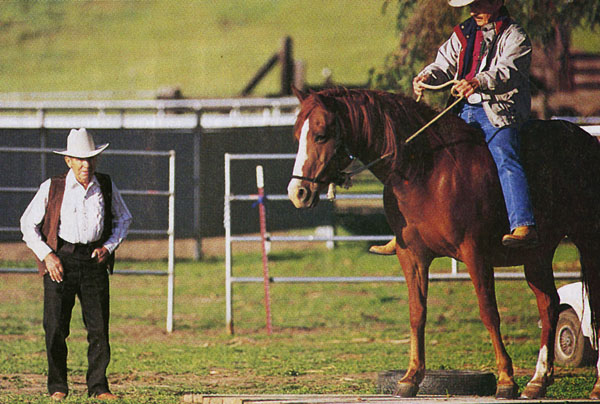
“He’ll set up a situation that will enable you to see and feel what’s happening, then let you discover on your own how the horse will respond,” says Jody Semper, a cutting and cow horse enthusiast who met Tom in 1990 and has been seeking his guidance ever since.
“In catching a horse, for example, he’ll tell you how to position yourself and when and how to turn, until eventually the horse realizes he’s already ‘caught,’ and so turns and ‘presents’ himself to you. Only then do you halter him.”
Such strategies allow the horse to “teach himself” as well.
Colt savvy. “When you’re riding a colt for the first time,” Semper explains, “typically with a halter and lead rope instead of a bridle, Tom will tell you how to run your hand down the rope toward the horse’s nose, then hold the rope out to the side, and just wait. You never pull the horse around; you ‘wait for the feet,’ as Tom says.”
Eventually the horse figures out that bending and turning are the most natural things to do under the circumstances, and so he “comes through” on his own. This patient, passive approach is the source of Ray Hunt’s familiar credo: “Cause the wrong thing to be difficult and the right thing to be easy.”
Though the learning can be a challenge for students, Tom’s endless optimism and positive outlook keep them motivated and encouraged.
“He just doesn’t have a negative thought or word in him,” says Semper, wonderingly. “He’s almost not human that way.” Tom avoids words like correcting in favor of such terms as directing and supporting. It may seem all semantics, but it springs from a genuine desire to maintain a positive approach and avoid being punitive.
“People always say to me, ‘What am I doing wrong?,” says Tom. “I say, ‘You’re not doing anything wrong. But here’s a different approach that might be more fitting for the need or the occasion.’”
Attitude matters. Like all who understand that a positive attitude underlies most success in life, Tom believe events aren’t as important as our response to them.
“It doesn’t matter so much if something comes out good or bad,” he says. “The important thing is to try to understand what took place that caused it to be good or bad.”
Tom also believes that what you “see” is what you’ll get.
“Looking for the good in horses is something I’ve always done,” he says. “Over the years, I’ve come to realize the need to do the same thing for humans, too.” So he does.
Such positivity has served Tom well in all areas of his life—including his relationship with his wife, a horsewoman who, Tom claims, “pretended to have a horse problem” to get him, at 56, “blindfolded, haltered, hogtied, and saddled.” That was in 1966; 31 years later, Tom still refers to the marriage as “the best thing that ever happened to me.”
Not completing the eighth grade (“I flunked agriculture and grammar on the final exam”) hasn’t fazed him either. For example, in 1975 he invented an ingenious solar-powered automatic gate, a descendant of which now stands at the entrance to the property where he lives.
“To really appreciate Tom, you have to understand all the things his mind is into,” says Joyce Mattos, a horsewoman who’s studied under him and helps to organize his clinics. “He’s a diverse, creative thinker.”
The horse’s spirit. One area Tom’s mind has been drawn to in his later years is the horse’s intrinsic value as a living being.
“As I think back through the years, I realize I’ve felt the horse’s spirit all my life, but didn’t have a name for it,” he says. “I’m beginning to believe it may be the most important factor—that the rider recognize the horse’s need for self-preservation in mind, body, and spirit.”
In other words, respect a horse’s right to be a horse, in all that that implies. Or, as Greg Ward bluntly puts it, “The horse is not a John Deere tractor.”
It’s easy to see why Tom’s been called “the horse’s lawyer.” No one represents the animal better, or defends its basic rights to dignity and humane treatment with more eloquence. At the same time, no one is better at drawing willing cooperation and fine performance out of the animal.
Now, that’s something to think about, isn’t it?
Life Lessons
Near the end of our interview, my mind is reeling. Clearly, the wisdom Tom has for us applies to more than just training horses. Indeed, it focuses on how we live our lives.
I’m reminded of what an admirer says in True Unity: “I’ve seen many over-enthusiastic students cooled off fast when they find Tom’s message isn’t a bunch of secret training tips, but ways you can work on yourself.”
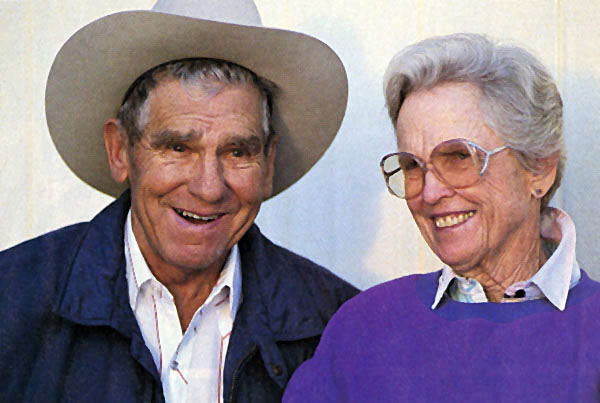
Accept the self-improvement challenge, though, and the rewards are dear.
“If I had to point to one thing in my life that’s enriched me, it would be Tom’s philosophy,” says Mattos, speaking for many. “It’s influenced how I look at so many things, and enabled me to get more out of life—satisfaction, relaxation, even excitement.”
Toddler ‘whisperer.’ As I stand to leave, I wish I had more days to spend with Tom, so I could delve into other areas—religion, relationships, child rearing. My daughter Sophie wanders back in and pauses in front of Tom’s chair. Like most youngsters her age, she’s shy of strangers, especially men.
Tom extends his forefinger to her, “asking” her to take it.
Oh, no, Tom, don’t, I think, fearing the embarrassment of failure for him. I know my child.
Their gazes lock, and Sophie is about to drop her head and turn away when Tom suddenly turns his head away, averting his gaze.
As if drawn by unseen forces, Sophie’s little hand shoots forward and locks onto his finger. Tom turns back with a smile, shaking his finger gently as she grips it.
Each time she shows any hesitation, he simply turns his head again, and she stand there comfortably, “holding hands” with an almost complete stranger.
Will this newfound insight into child psychology prove useful to me in the future? Probably. But I now know only one thing for sure.
It all depends—on me.






